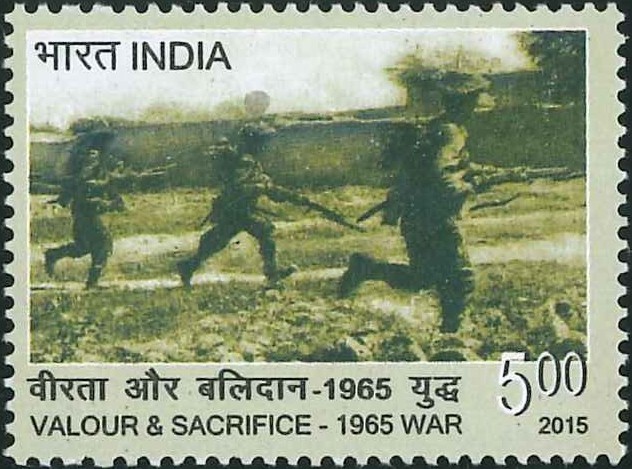
Marshal of the Indian Air Force Arjan Singh DFC
A commemorative postage stamp on Arjan Singh, first and only officer of the Indian Air Force to be promoted to 5-star rank as Marshal of the Indian Air Force, equal to the army rank of Field Marshal :
 Issued by India
Issued by India
Issued on Oct 9, 2019
Issued for : Arjan Singh was and remains a source of inspiration to generations of Indians. For his immense contribution to the country and IAF in particular, DoP is pleased to release a Commemorative Postage Stamp in honour of Marshal of the Indian Air Force Arjan Singh DFC during the 87th Anniversary celebrations of the Indian Air Force in October 2019.
Credits :
Stamp/FDC/Brochure : Ms. Gulistaan
Cancellation Cachet : Smt. Nenu Gupta
Type : Stamp, Mint Condition
Colour : Multi Colour
Denomination : 500 Paise
Stamps Printed : 600039
Printing Process : Wet Offset
Printer : India Security Press, Nashik
Name : Arjan Singh
Born on Apr 15, 1919 at Lyallpur, Punjab, British India [now Faisalabad, Pakistan]
Died on Sep 16, 2017 at New Delhi, India
About :
- Marshal of the Indian Air Force Arjan Singh DFC was commissioned in the Royal Air Force (RAF) on 23 December, 1939. He served as Chief of the Air Staff (CAS) from 1964 to 1969. He was awarded the Padma Vibhushan for his distinguished service in commanding the Indian Air Force (IAF) during the Indo-Pakistan War of 1965. He was the first IAF officer to be promoted to the rank of Air Chief Marshal in 1966. He was assigned various important diplomatic and constitutional appointments after he retired as the Air Chief in the year 1969. In 2002, he became the first and only officer of the Indian Air Force to be promoted to five-star rank as Marshal of the Air Force, equivalent to the army rank of Field Marshal.
- Arjan Singh was born on 15 April, 1919 in Lyallpur, Punjab (now known as Faisalabad, Pakistan) in what was then undivided India, into a Sikh family. Arjan Singh was educated at Montgomery, British India (now in Pakistan). In 1938, at the age of 19, he was selected for the Empire Pilot Training Course at the RAF College, Cranwell. He was commissioned as a Pilot Officer in December, 1939.
- His first posting on being commissioned involved flying Westland Wapiti biplanes in the North Western Frontier Province as a member of the No. 1 IAF Squadron. Arjan Singh flew against the tribal forces before he was transferred for a brief stint with the newly formed No. 2 IAF Squadron. Later he moved back to No. 1 Sqn. as a Flying Officer, when the Squadron was re-equipped with the Hawker Hurricane. In 1944, he was promoted to the rank of Squadron Leader and became the Commanding Officer of No. 1 Squadron. He flew close support missions during the crucial Imphal Campaign and later assisted the advance of the Allied Forces to Rangoon, Burma. For his role in successfully leading the squadron during combat, Arjan Singh received the Distinguished Flying Cross in 1944. He was given command of the IAF Display flight, which flew Hawker Hurricanes after the war, which toured India giving demonstrations. On 15 August 1947, he was given the unique honour of leading the fly-past of more than a hundred IAF aircraft over the Red Fort in Delhi.
- Immediately after independence, Arjan Singh took over the command of Air Force Station, Ambala, in the rank of Group Captain. In 1948, the late Marshal married Teji Singh. They were married for 63 years before Mrs. Singh passed away in April 2011. In 1949, after promotion to the rank of Air Commodore, Arjan Singh took over as the Air Officer Commanding of an Operational Command, which later came to be known as the Western Air Command. Arjan Singh had the distinction of having the longest tenure as AOC of Operational Command, from 1949-1952 and again from 1957-1961. Promoted to Air Vice Marshal, he was the AOC-in-C of Operational Command. Towards the end of 1962 war, he was appointed as the Deputy Chief of Air Staff and became the Vice Chief of Air Staff by 1963. On 01 Aug 1964, Arjan Singh took over as the Chief of Air Staff (CAS) in the rank of Air Marshal. Arjan Singh was the first Air Chief who kept his flying category till the CAS rank. Having flown over 60 different types of aircraft from pre-second World War era biplanes to the more contemporary Gnats & Vampires, he had also flown transports like the super constellation.
- A testing time came in September 1965 when Pakistan launched Operation Grand Slam, in which an armored thrust targeted the vital town of Akhnur. He was summoned into Defence Minister’s office with a request for air support. When asked how quickly the IAF will be ready for operations, he replied with his characteristic nonchalance, “in an hour”. And true to his word, the Air Force struck the Pakistani offensive in an hour. He led the IAF through the war showing unparalleled leadership.
- Arjan Singh was awarded the Padma Vibhushan for his leadership during the 1965 War and subsequently the rank of CAS was upgraded to that of Air Chief Marshal and he became the first Air Chief Marshal of the Indian Air Force.
- In 1969, after his retirement, Air Chief Marshal Arjan Singh was appointed as the Indian Ambassador to Switzerland and Vatican serving concurrently. He was also appointed as the High Commissioner to Kenya from 1974 to 1977. Subsequently, he served as a member of the National Commission for Minorities in the Government of India from 1975 to 1981. He served as the Lt Governor of Delhi from December 1989 to December 1990. In recognition of his services, the Government of India conferred the rank of the Marshal of the Indian Air Force onto Arjan Singh in January, 2002 making him the first and the only ‘Five Star’ rank officer of the Indian Air Force. In 2016, Air Force Station, Panagarh was renamed as Air Force Station Arjan Singh in his honour.
- Arjan Singh breathed his last on 16 September, 2017.
- Text : Based on information received from the proponent.







